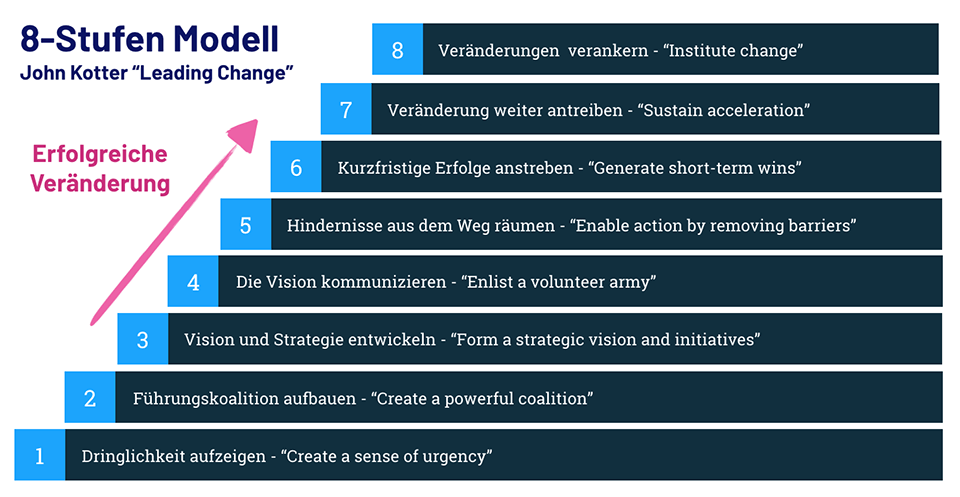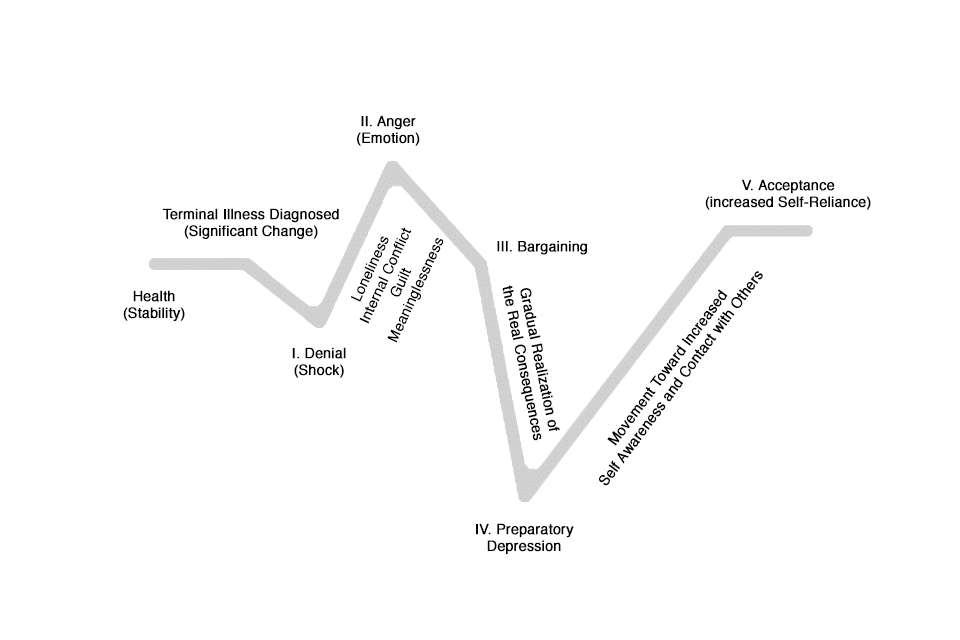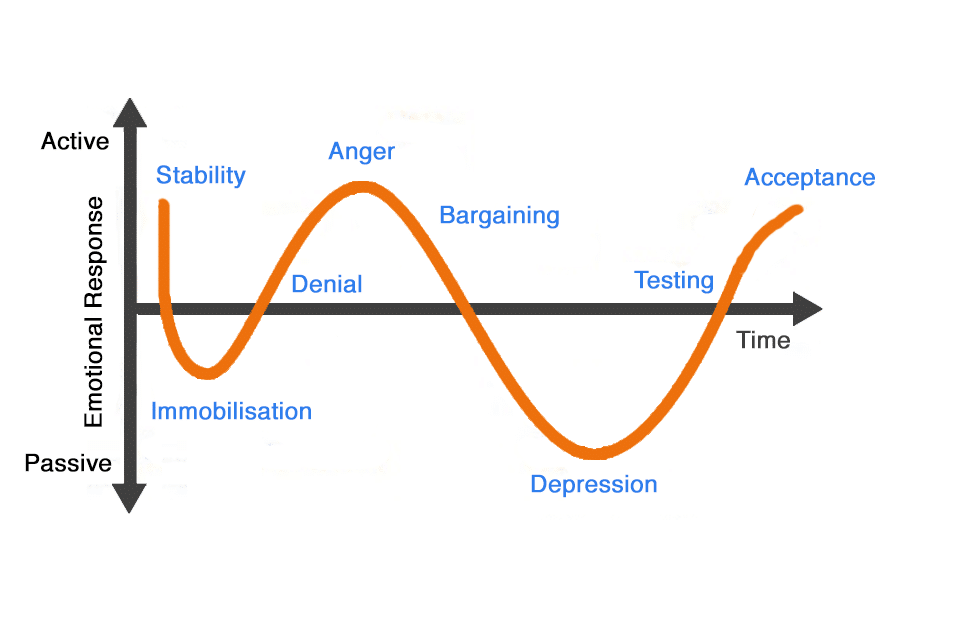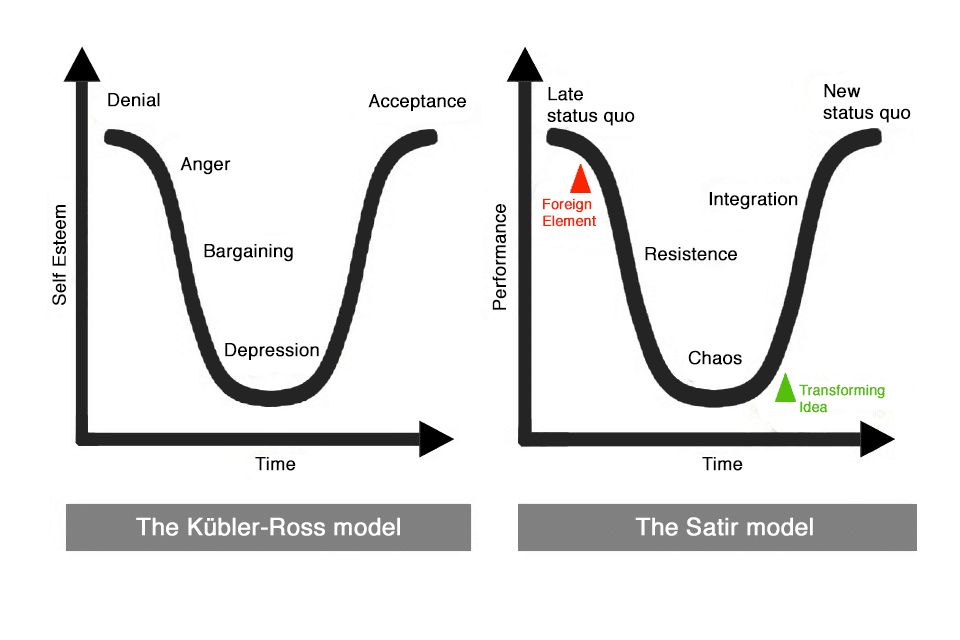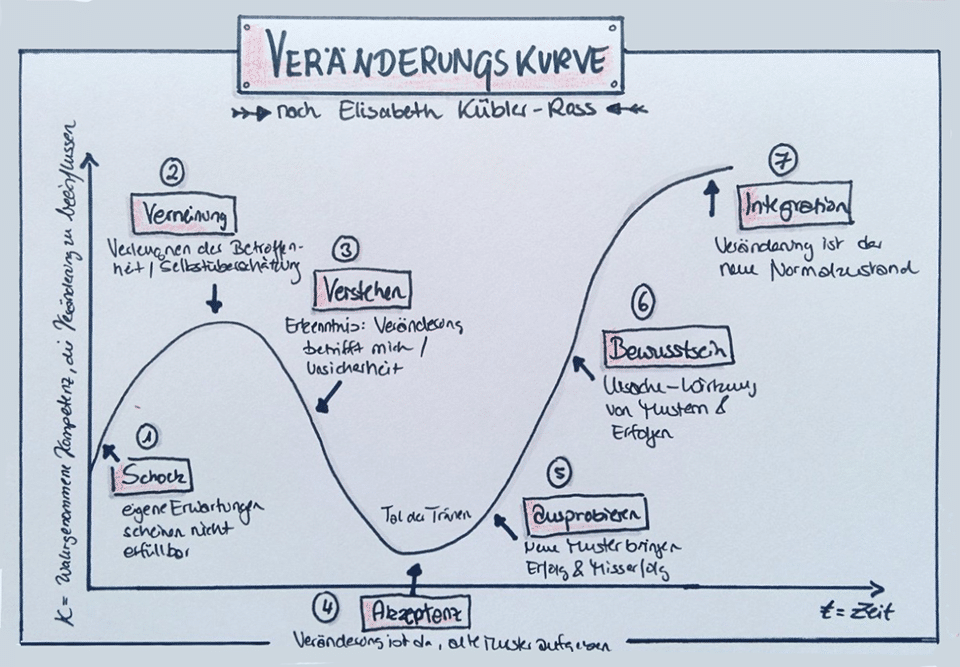Dealing with change
Table of Contents
3-Phase Model according to Kurt Lewin
8-Stage Model according to John Kotter
The Process of Dying by Elisabeth Kübler-Ross
Transformation Curve According to Virginia Satir
The 7 Phases of Transformation according to Kübler-Ross/Satir
No Change is like the Other
Suffering Creates Change – or rather the other way round
Conclusion
“Of course, I cannot say whether it will become better if it becomes different; but I can say this much: it must become different if it is to become good.” – Georg Christoph Lichtenberg
An excellent quote to start with on a topic that accompanies us throughout our lives. No matter whether professionally or privately. Life is full of goodbyes and full of new starts and you would think it is part of our lives and we should be practiced in experiencing change. However, many of us avoid it or at least experience it as extremely stressful. In times of digital or cultural transformation, changing activities, globalisation and the associated mobility, we are confronted with so many challenges that it seems worthwhile to work on our own change competence.
This is exactly what this article is about: how can I build up my resilience in dealing with crises and changes? What is also helpful when I trigger transformation processes in the work context and, for example, accompany such processes in the role of a manager?
In my presentations on this topic, I usually start with classics from the field of change management, various models that depict typical processes of change and thus explain our own or others’ emotions and behaviours.
3-Phase Model According to Kurt Lewin
A rather reduced and often quoted model is that of the three phases by Kurt Lewin
Phase 1: Unfreezing (loosening up)
Phase 2: Moving
Phase 3: Freezing of Group Standards (Stabilising)
Lewin developed this after the end of World War II and it has become known as the Model of Change. The model is often applied to transformations in organisations. Organisations must first be unfrozen to make them ready for change and then frozen again.
8-Stage Model according to John Kotter
Kotter built on Lewin’s model in the 1990s. In 1994, he originally described his 8-step model, which is well-known among business economists, in an issue of the Harvard Business Review. Kotter became known in particular for his book “Leading Change – How to successfully change your company in eight steps” (1996).
The 8-steps of change according to Kotter:
- Create a sense of urgency
- Build a leadership coalition
- Develop vision and strategy
- Communicate the vision of change
- Empowering staff across the board
- Achieve rapid success
- Consolidate successes and initiate further change
- Embed new approaches in the culture
The Process of Dying by Elisabeth Kübler-Ross
When describing models of the process of change, Elisabeth Kübler-Ross must not be left out. The psychiatrist published her book “On Death and Dying” in 1969. For this book, the Swiss-born American talked to numerous seriously ill and grieving people. Kübler-Ross divided the process of dying into five phases:
- Denial
- Anger
- Negotiation
- Depression
- Acceptance
Later, Kübler-Ross expanded the model to show the emotional response of people in the course of a change. People who were confronted with significant personal life events involving loss or alteration – such as loss of employment, death of a loved one, divorce, etc.
In particular, the following figure should be familiar to many who have already dealt with change on a psychological level:
Transformation Curve According to Virginia Satir
In addition to the Kübler-Ross model, there is a similar model by the systemic family therapist Virginia Satir. The difference to Kübler-Ross’ curve is mainly that Kübler-Ross focuses on the changing self-esteem on the vertical axis, while Satir describes the vertical axis with the ability or performance of the person affected by the change.
Based on the process of therapeutic accompaniment, the following phases can be named in the Satir model:
Phase 1: Status quo
Phase 2: Introduction of a foreign element (establishing contact, examining expectations, examining barriers, resistance, reinterpreting resistance in the direction of dignity)
Phase 3: chaos (normalising anxiety and fear, revealing family rules)
Phase 4: new choices and integration
Phase 5: Implementation
Phase 6: The new status quo – healthier balance
The 7 Phases of Transformation According to Kübler-Ross/Satir
The 7-phase model is often used to explain emotions in change processes and to derive communicative measures.
The vertical axis shows the degree of perceived competence, the possibility of influencing the person affected by a change over time.
Starting with the shock of a communicated change, the model shows that this is often followed by rejection of the circumstances or acted out resistance to the point of grasping reality, saying goodbye to the past, accepting the new and then transitioning towards the new world, experimentation to the new normal.
No Change is Like the Other
The criticism of these models is the rigidity of the respective model. Nevertheless, I have repeatedly experienced that it helps people to know that other people in similar situations experience and, above all, feel similar things. In systemic counselling and coaching we talk about the normalisation of a circumstance or a situation. It creates a feeling of not being alone and feeling connected to others.
Nevertheless, no reaction to an upcoming change can really be predicted. Neither with you personally, nor with your employees and colleagues. It always depends on the type of shift, the people involved and the context.
For example, if a team has received an introduction to agile working in the past, but had a bad experience, then another announcement of a new agile project often has much worse chances. However, if the team has changed, old team members have left, others have joined, and the agile coach uses the right words for the moment, the announced changes may have much more success.
Suffering Creates Change – or Rather the Other Way Round?
Many people fundamentally reject change. In our origins, we strive for security. This is one of our basic psychological needs. If our lives run in an orderly fashion, in fixed structures, this gives us precisely this form of security. In addition, structures and fixed processes save our brain resources. Every shift is a new construction site for our brain. The road must first be laid out anew, so to speak, in order to be travelled quickly later. Depending on how our personality is wired, we learn to move more quickly on new roads than others or we find this more challenging than frightening and like to explore new paths.
If we are also aware of our own (change) competence, we can make use of it, a change seems less challenging to us and thus manageable.
In the working world, dealing with change is often a great challenge, especially for managers or initiators of change processes. It requires good preparation and communication of an upcoming change, as well as an empathetic, mindful approach to possible arising emotions and behaviours of all participants. Here it helps to take other basic psychological needs of us humans into consideration. According to Klaus Grawe, we always strive for autonomy. Therefore, in all forums, it is always promoted to involve employees in the change processes. If people feel they can influence their situation, they can become self-effective, they do not feel at the mercy of others and are more likely to move towards acceptance, resolution and a future. Not only another basic need but also an important resilience factor is the existence of a stable social fabric. How often do we hear the saying that working conditions are almost unbearable, but the togetherness, the colleagues are worth staying. If we take this into account in times of change, we may find a change or even a crisis less stressful.
Conclusion
It often helps people to understand how typical reactions to change can occur, what the reasons are for them and that they are not alone in this.
Quite apart from the models described, which show us these typical processes and ways of reacting in change processes, as well as the influencing factors listed on how a change can be experienced more calmly, I would like to refer here to resilience research. This relatively young field of research (research began in the 1960s) is certain that our resilience in the face of shift and crises can be developed and built up. Thus, we learn from experienced change to experienced change and in this way can also develop an increasingly relaxed way of dealing with change. More about this in the next article.
Notes:
This is a best of blog 2021 article.
Sandra Brauer has published additional articles in the t2informatik Blog:

Sandra Brauer
Sandra Brauer – change management with system – is a systemic consultant and trainer for stress management, mindfulness and relaxation. The studied business economist accompanies companies and individuals in change processes. Her main focus is on the accompaniment of digitalisation and change projects, especially in the course of cultural change. Sandra Brauer can be booked for workshops, team reflections, individual consulting and coaching, moderation of panel discussions and impulse lectures.
